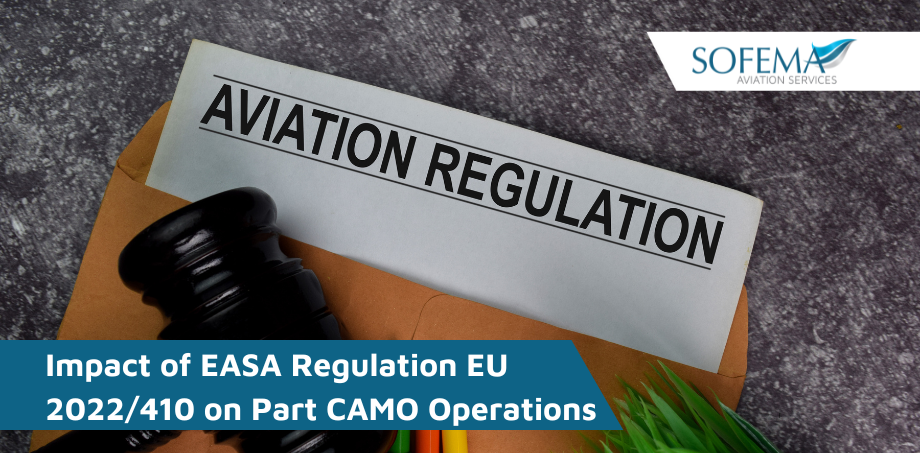Sofema Aviation Services (SAS) www.sassofia.com considers the impact of the CAMO change introduced by EASA Regulation EU 2022/410, which primarily affects a single air carrier business grouping.
Introduction
According to Annex I (Part-M) to Regulation (EU) No 1321/2014, in the case of aircraft used by air carriers licensed in accordance with Regulation (EC) No 1008/2008 of the European Parliament and of the Council:
- The operator is to be responsible for the continuing airworthiness of the aircraft it operates and;
- Shall be approved, as part of its air operator certificate, as a continuing airworthiness management organisation (‘CAMO’) pursuant to Annex Vc (Part-CAMO).
Air carriers licensed in accordance with Regulation (EC) No 1008/2008 that form part of a single air carrier business grouping may contract a CAMO within that grouping for the continuing airworthiness management of aircraft operated by them.
Note – ‘management systems harmonisation’ means the coordinated process by which the management systems of two or more organisations interact and share information and methods to reach common or consistent safety and compliance monitoring objectives.’;
Implementation
By derogation to point (e)(2), at least two operators forming part of a single air carrier business grouping may use the same CAMO to assume the responsibility for the continuing airworthiness management of all the aircraft they operate, provided that all of the following requirements are met:
- The CAMO is approved in accordance with Annex Vc (Part-CAMO) for the aircraft to be managed;
- The CAMO forms part of the same air carrier business grouping as the operators concerned;
- A contract is established in accordance with Appendix I to this Annex between the CAMO and the AOC holder, not itself approved as a CAMO;
- The CAMO has its principal place of business in the territory to which the Treaties apply;
- The individual management systems of the organisations concluding a contract are harmonised with each other.
Note Regarding Termination
When the termination or revocation of an air operator certificate results in a situation where an air carrier licensed in accordance with Regulation (EC) No 1008/2008 and forming part of an air carrier business grouping is no longer in compliance with point M.A.201 that licensed air carrier shall define and implement an action plan to the satisfaction of the competent authority to comply with point M.A.201(e)(2) as soon as practicable.
Additional obligations of the CAMO:
- Become knowledgeable about the operator’s procedure related to the monitoring of the contract;
- Obtain the agreement from the operator before subcontracting continuing airworthiness tasks;
- Inform immediately the competent authority of the Member State of registry whenever the aircraft is not presented to the approved maintenance organisation by the operator as requested by the CAMO, when the present contract is not respected or when the contract is denounced by either party;
- Provide training for the operator’s staff to ensure that they have an understanding of the CAMO’s:
- Policies and procedures, responsibilities, obligations, duties and areas of interface;
- Lines of communication (for example aircraft records, exchange of accurate airworthiness information in a timely manner including outside of normal working hours);
- Procedures pertaining specifically to the CAMO such as customised software utilisation, reliability monitoring, use of the aircraft technical log system, and interoperability provisions.
Additional obligations of the operator:
- Develop interface procedures with the CAMO to address the issue and renewal of the airworthiness review certificate;
- In case of unexpected maintenance needs in locations where no maintenance organisation approved in accordance with Annex II (Part-145) to this Regulation is contracted, inform immediately the CAMO;
- Inform immediately the competent authority of the Member State of registry whenever the contract is denounced by either party;
- Provide training for the CAMO staff in order to ensure that they have an understanding of the operator’s:
- Policies and procedures, responsibilities, obligations, duties and areas of interface;
- Lines of communication;
- Procedures pertaining specifically to the operator such as operational procedures, customised software utilisation, use of the aircraft technical log system, and interoperability provisions.
Next Steps
Follow this link to our Library to find & Download related documents for Free.
Sofema Aviation Services www.sassofia.com and Sofema Online www.sofemaonline.com provide Classroom, Webinar, and Online training. For additional information please visit our websites or email team@sassofia.com
Tags:
Air Carriers, Airworthiness, aviation, CAMO, EASA, EASA Part CAMO Organisation, EASA Part M, EASA Regulation 1321/2014, Part CAMO, Regulation (EC) No 1008/2008, Regulation EU 2022/410




